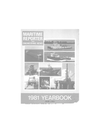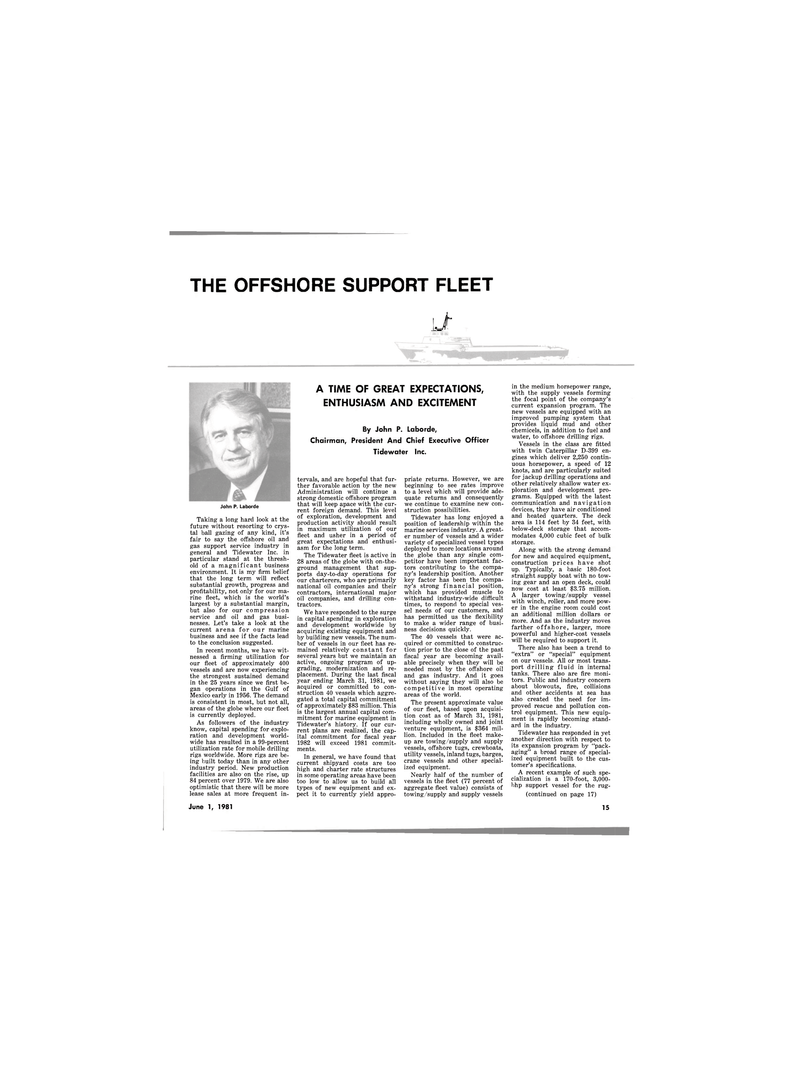
Page 15: of Maritime Reporter Magazine (June 1981)
Read this page in Pdf, Flash or Html5 edition of June 1981 Maritime Reporter Magazine
THE OFFSHORE SUPPORT FLEET 'J
A TIME OF GREAT EXPECTATIONS,
ENTHUSIASM AND EXCITEMENT
By John P. Laborde,
Chairman, President And Chief Executive Officer
Tidewater Inc.
John P. Laborde
Taking a long hard look at the future without resorting to crys- tal ball gazing of any kind, it's fair to say the offshore oil and gas support service industry in general and Tidewater Inc. in particular stand at the thresh- old of a magnificant business environment. It is my firm belief that the long term will reflect substantial growth, progress and profitability, not only for our ma- rine fleet, which is the world's largest by a substantial margin, but also for our compression service and oil and gas busi- nesses. Let's take a look at the current arena for our marine business and see if the facts lead to the conclusion suggested.
In recent months, we have wit- nessed a firming utilization for our fleet of approximately 400 vessels and are now experiencing the strongest sustained demand in the 25 years since we first be- gan operations in the Gulf of
Mexico early in 1956. The demand is consistent in most, but not all, areas of the globe where our fleet is currently deployed.
As followers of the industry know, capital spending for explo- ration and development world- wide has resulted in a 99-percent utilization rate for mobile drilling rigs worldwide. More rigs are be- ing built today than in any other industry period. New production facilities are also on the rise, up 84 percent over 1979. We are also optimistic that there will be more lease sales at more frequent in- tervals, and are hopeful that fur- ther favorable action by the new
Administration will continue a strong domestic offshore program that will keep apace with the cur- rent foreign demand. This level of exploration, development and production activity should result in maximum utilization of our fleet and usher in a period of great expectations and enthusi- asm for the long term.
The Tidewater fleet is active in 28 areas of the globe with on-the- ground management that sup- ports day-to-day operations for our charterers, who are primarily national oil companies and their contractors, international major oil companies, and drilling con- tractors.
We have responded to the surge in capital spending in exploration and development worldwide by acquiring existing equipment and by building new vessels. The num- ber of vessels in our fleet has re- mained relatively constant for several years but we maintain an active, ongoing program of up- grading, modernization and re- placement. During the last fiscal year ending March 31, 1981, we acquired or committed to con- struction 40 vessels which aggre- gated a total capital commitment of approximately $83 million. This is the largest annual capital com- mitment for marine equipment in
Tidewater's history. If our cur- rent plans are realized, the cap- ital commitment for fiscal year 1982 will exceed 1981 commit- ments.
In general, we have found that current shipyard costs are too high and charter rate structures in some operating areas have been too low to allow us to build all types of new equipment and ex- pect it to currently yield appro- priate returns. However, we are beginning to see rates improve to a level which will provide ade- quate returns and consequently we continue to examine new con- struction possibilities.
Tidewater has long enjoyed a position of leadership within the marine services industry. A great- er number of vessels and a wider variety of specialized vessel types deployed to more locations around the globe than any single com- petitor have been important fac- tors contributing to the compa- ny's leadership position. Another key factor has been the compa- ny's strong financial position, which has provided muscle to withstand industry-wide difficult times, to respond to special ves- sel needs of our customers, and has permitted us the flexibility to make a wider range of busi- ness decisions quickly.
The 40 vessels that were ac- quired or committed to construc- tion prior to the close of the past fiscal year are becoming avail- able precisely when they will be needed most by the offshore oil and gas industry. And it goes without saying they will also be competitive in most operating areas of the world.
The present approximate value of our fleet, based upon acquisi- tion cost as of March 31, 1981, including wholly owned and joint venture equipment, is $364 mil- lion. Included in the fleet make- up are towing/supply and supply vessels, offshore tugs, crewboats, utility vessels, inland tugs, barges, crane vessels and other special- ized equipment.
Nearly half of the number of vessels in the fleet (77 percent of aggregate fleet value) consists of towing/supply and supply vessels in the medium horsepower range, with the supply vessels forming the focal point of the company's current expansion program. The new vessels are equipped with an improved pumping system that provides liquid mud and other chemicels, in addition to fuel and water, to offshore drilling rigs.
Vessels in the class are fitted with twin Caterpillar D-399 en- gines which deliver 2,250 contin- uous horsepower, a speed of 12 knots, and are particularly suited for jackup drilling operations and other relatively shallow water ex- ploration and development pro- grams. Equipped with the latest communication and navigation devices, they have air conditioned and heated quarters. The deck area is 114 feet by 34 feet, with below-deck storage that accom- modates 4,000 cubic feet of bulk storage.
Along with the strong demand for new and acquired equipment, construction prices have shot up. Typically, a basic 180-foot straight supply boat with no tow- ing gear and an open deck, could now cost at least $3.75 million.
A larger towing/supply vessel with winch, roller, and more pow- er in the engine room could cost an additional million dollars or more. And as the industry moves farther offshore, larger, more powerful and higher-cost vessels will be required to support it.
There also has been a trend to "extra" or "special" equipment on our vessels. All or most trans- port drilling- fluid in internal tanks. There also are fire moni- tors. Public and industry concern about blowouts, fire, collisions and other accidents at sea has also created the need for im- proved rescue and pollution con- trol equipment. This new equip- ment is rapidly becoming stand- ard in the industry.
Tidewater has responded in yet another direction with respect to its expansion program by "pack- aging" a broad range of special- ized equipment built to the cus- tomer's specifications.
A recent example of such spe- cialization is a 170-foot, 3,000- bhp support vessel for the rug- (continued on page 17)
June 1, 1981 15

 14
14

 16
16
